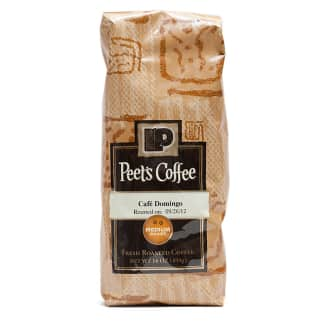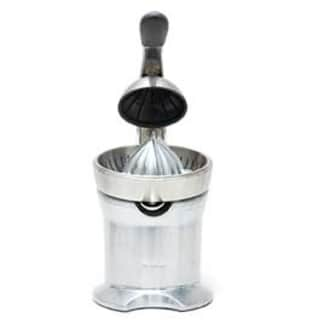Reviews You Can Trust.
See Why.
Orange Juice
Is the sunny image of our favorite breakfast juice actually just pulp fiction?
Top Pick
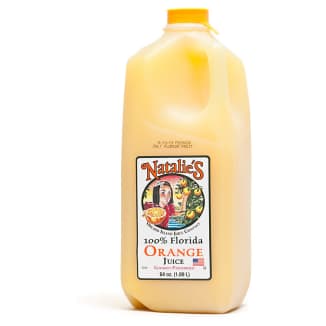
WinnerNatalie's 100% Florida Orange Juice, Gourmet Pasteurized
Sign up for the Well-Equipped Cook newsletter
Shop smarter with our ATK Reviews team's expert guides and recommendations.
What You Need to Know
Orange juice is America’s most popular juice, a breakfast staple with a sunny, wholesome image. Package labels tempt us with phrases like “fresh squeezed” and “grove to glass” and with images of oranges speared with straws. Even brand names like Simply Orange and Florida’s Natural suggest that these juices are just a notch away from freshly picked fruit squeezed into a glass. There’s financial proof that these companies’ fresh-focused marketing pays off. According to a 2010 report published by the University of Florida Institute of Food and Agricultural Sciences Extension, Americans will shell out $1 to $2 more per gallon for juice that they perceive to be fresher.
But the truth is, commercial orange juice can’t be that simple an enterprise because of the complex challenge that manufacturers face. What’s at stake: how to produce (and profit from) a juice that has fresh and consistent flavor 365 days a year and a shelf life long enough to withstand transport to and storage in supermarkets. Mind you, this is all from a seasonal fruit crop with natural variation in flavor and that is susceptible to the whims of disease, bugs, and volatile weather patterns.
Given that, technology is the core focus of companies trying to engineer the most natural-tasting product. Case in point: Coca-Cola, which owns the major players Simply Orange and Minute Maid, has developed a staggeringly precise algorithm to aid in processing juice, according to a 2013 Bloomberg Businessweek investigation. Called Black Book, it reportedly analyzes 1 quintillion variables that affect the juice-making process, including the 600-plus volatiles responsible for optimal juice flavor, as well as erratic weather patterns, crop yields, and cost. The company also uses satellites to track when it should harvest the fruit. The upshot: If a hurricane barrels through Florida (or any other global region) or a cold snap threatens the trees, the company can remap its production model in less than 10 minutes.
These systems certainly turn a profit: Last year, Coca-Cola and Pepsi, which owns the other major producer, Tropicana, each pulled in $1 billion of the $3.9 billion spent on orange juice in the United States. But as for the real question—whether these high-tech advances make for better-tasting juice—we’d have to see for ourselves.
To find out, we built a tasting lineup around five nationally available refrigerated orange juices. (We selected medium pulp when available, as it’s the style most akin to fresh squeezed and often the most popular.) We also included two frozen concentrates, because in previous tastings they’ve rated surprisingly high. And we threw in two lower-calorie juices—an increasingly popular subcategory made by cutting juice with water and sweetening it with stevia. All nine juices were served lightly chilled and evaluated for freshness, flavor, texture, and overall appeal.
Label Sleuthing
Tasters panned the two lower-calorie juices for tasting “ridiculously sweet” and “cloying”—evidence that these producers may have overdone it with the stevia, which is up to 300 times sweeter than granulated sugar. As for the other juices, three self-described “gourmet” or “pure” products earned the highest marks, with tasters touting their “nice balance of acidity and sweetness” and “fresh,” “honest” flavors. These juices were followed by the two frozen concentrates and a straightforward supermarket brand, and then by an outlier: our previous winner.
However, the buzzwords on the labels didn’t help explain why some juices performed better, as none of those terms are industry-regulated. Also not helpful were the juices’ nutrition labels, which indicated that all seven full-calorie samples had the same single ingredient—orange juice—and nearly identical nutritional makeups. That left us looking to processing methods for clues—an investigation that showed us just how far from fresh squeezed most commercial orange juice really is.
A Lengthy Process
We figured that pasteurization would be an obvious place to start, particularly because a couple of the top-ranking products advertised that their juices were “gently pasteurized.” But in most cases we were thwarted in our efforts to tie better flavor to juice being subjected to lower heat. It turns out that the U.S. Food and Drug Administration (FDA) doesn’t recognize the term “gently pasteurized,” and most producers won’t elaborate on what they mean by it either. Only one other juice, another top performer, shared a pasteurization detail with us that indicated that the company is being gentler with its juice. The manufacturer heats it to around 160 degrees, which is the minimum pasteurization temperature recommended by the FDA to ensure safety and shelf-life stability. It’s a temperature that industry experts say is, in fact, lower than what most juice makers use.
Still in search of other reasons for the flavor differences we perceived, we moved on to examine the next stage of orange juice processing: storage. Because different varieties of oranges are in season at different times, most manufacturers squeeze the juice immediately and store it for months to maintain a year-round supply of particular varieties. To keep the juice from turning rancid, they must prevent it from oxidizing. These days, the answer for most companies is deaeration, a process in which they strip away the juice’s oxygen and store the juice, sometimes for as long as a year, in million-gallon tanks—so-called tank farms—topped with a layer of nitrogen to prevent further deterioration. (When used to replace air in a container, nitrogen provides effective protection against oxidation.)
The downside is that stripping the oxygen out of juice also strips out the juice’s flavor-providing compounds. That’s where blend technicians, who correct for flavor deficiencies, come in. Their job isn’t simply a matter of blending multiple batches of juice to balance sweetness and acidity (though this is part of their process, and experts told us that blending likely contributed to some of the flavor differences that we detected). The technicians also restore taste to the juice through the addition of “flavor packs.” These highly engineered additives are made from essential orange flavor volatiles that have been harvested from the fruit and its skin and then chemically reassembled by scientists at leading fragrance companies: Givaudan, Firmenich, and International Flavors and Fragrances, which make perfumes for the likes of Dior, Justin Bieber, and Taylor Swift. By reorganizing these compounds, scientists are able to compensate for the flavor-destroying effects of pasteurization and deaeration, and to tailor the flavor of the packs—and by extension the flavor of the juice—to each juice company’s exact specifications.
The Fresh Maker
But while the blending process and the addition of flavor packs enable juice companies to develop a distinct flavor profile and guarantee that flavor from bottle to bottle, those factors don’t make a company unique. Juice blending is an industry-wide practice, and most of the juices that we tasted were enhanced by flavor packs. What we learned is that the makers of our top-ranking juices did a better job of figuring out and executing the exact flavor profile that consumers wanted.
That’s no small task, as orange juice expert Alissa Hamilton explains in her book, Squeezed: What You Don’t Know About Orange Juice. In it, she cites Russell Rouseff, a longtime researcher at the Citrus Research and Education Center at the University of Florida, who points out that fresh orange juice flavor is one of the toughest to imitate because none of the compounds that contribute to the orange’s aroma “individually smell of orange.” Hence, blend technicians do the best they can, piecing together compounds that add up to orange flavor.
To make matters more complicated, consumer preferences vary across different cultures when it comes to orange juice flavor. Hamilton goes on to suggest that what North Americans want their juice to taste like differs from what consumers in South America and Mexico prefer, so juice companies often tweak their flavor pack formulas to vary the levels of perceived sweetness, freshness, and acidity.
In the United States, fresh flavor is paramount, so juice makers include a compound called ethyl butyrate in the flavor packs. This compound isn’t an artificial flavor: It occurs naturally in fresh-squeezed orange juice as an aroma, but because it’s volatile, much of it is driven off during pasteurization and deaeration. Adding more ethyl butyrate to the juice after these processes actually restores the impression of freshness. (Humans are far more sensitive to smell than to taste; 80 to 85 percent of what we characterize as flavor is actually due to aroma.)
We wanted to see for ourselves if ethyl butyrate was boosting our impression of freshness in the top-ranking juices, so we sent samples of all nine juices to an independent laboratory to get them analyzed for the compound. The results were convincing: Three of the juices that ranked highest for fresh flavor contained relatively high levels of ethyl butyrate (as high as 4.92 milligrams per liter), indicating that their respective companies were adding plenty of it to their flavor packs. (One note: While ethyl butyrate is technically natural, boosting fresh flavor in orange juice with flavor packs certainly is not, and there are currently multiple class action cases against orange juice companies for engineering products that are far more processed than they’re advertised to be.)
Notably, there were two exceptions to the lab results and how they tracked with our preferences. First, the juice containing the highest level of ethyl butyrate (8.53 milligrams per liter) was panned for its lack of fresh flavor—a discrepancy that we chalked up to this lower-calorie juice’s overwhelming sweetness, which masked any impression of freshness. (The other lower-calorie juice in our lineup also ranked high for sweetness and tanked for fresh flavor.)
Second, the other juice that ranked high for freshness contained a much lower amount of ethyl butyrate (1.01 milligrams per liter) compared with other “fresh-tasting” juices. But as it turns out, fresh-squeezed orange juice naturally contains about 1.19 milligrams of ethyl butyrate per liter, so the amount in that juice isn’t far off from what occurs naturally in the fruit.
Just Juice
That statistic made even more sense when we learned the juice by that manufacturer is, in fact, a genuinely much fresher product than other orange juices. Rather than create an illusion of freshness by treating juice that’s been deaerated with flavor packs, the manufacturer squeezes oranges to order and ships its juice within 24 hours. Short storage times also allow the company to forgo deaeration.
Because the company squeezes oranges year-round, the flavor of its juice shifts as different varieties come into season; tasters reported that the batch we sampled was “superfresh” and pleasantly “tropical,” with hints of mango, guava, and pineapple. It also has a much shorter shelf life than most commercial orange juices—26 days compared with about a year for juice that’s been deaerated. However, the manufacturer has a system in place to minimize dramatic seasonal flavor change: When Valencia season ends and early varieties like Hamlin are harvested in September and October, the company holds extra whole Valencias just above freezing in special climate-controlled rooms and blends their juice with juice from early oranges in October and November.
That kind of flavor variability might not be what consumers expect from their orange juice, but it doesn’t bother us. In fact, we named this juice our favorite because we think a juice that actually is fresher, not just engineered to taste that way, is worth seeking out—and paying a bit more for (it costs about 38 percent more than other high-ranking orange juices do).
But if you’re in the market for a juice that’s consistent from bottle to bottle and costs a bit less, our runner-up tastes “very fresh” and does a nice job of balancing sweetness and acidity. Unfortunately, we can no longer say the same of our previous winner. Tasters deemed this sample comparatively “tart” and “bitter”—comments that were confirmed by lab tests, in which it rated highest for acidity. It also appears that the U.S. marketplace agrees. Sales of our previous winner have fallen in recent years as two other juice manufacturers have taken on a larger share.
Cook's CountryWatch Now
Everything We Tested
Recommended

WinnerNatalie's 100% Florida Orange Juice, Gourmet Pasteurized

Simply Orange Not from Concentrate 100% Pure Squeezed Pasteurized Orange Juice, Medium Pulp

Minute Maid Pure Squeezed Never from Concentrate Pasteurized 100% Orange Juice, Some Pulp

Minute Maid Original Frozen Concentrated Orange Juice

Florida's Natural 100% Pure Florida Orange Juice, with Pulp
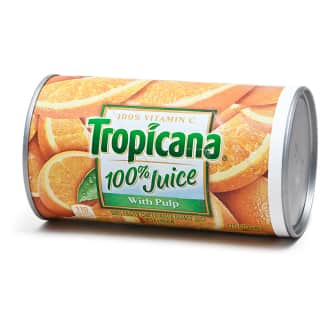
Tropicana 100% Frozen Concentrated Orange Juice
Recommended with reservations
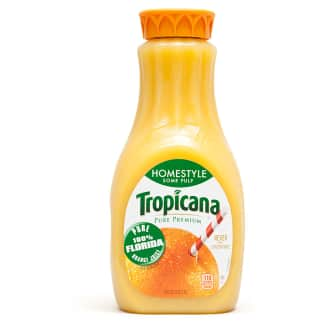
Tropicana Pure Premium Orange Juice, Homestyle
Not Recommended
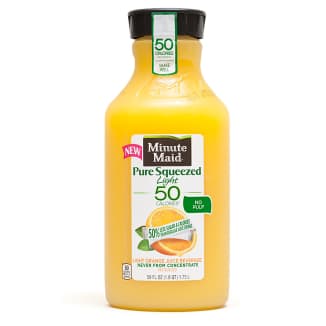
Minute Maid Pure Squeezed Light Orange Juice Beverage
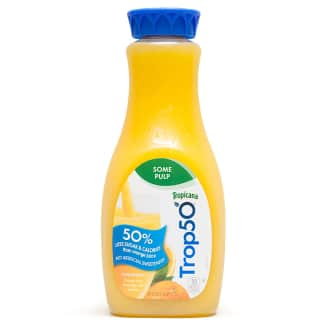
Tropicana Trop50 Orange Juice Beverage
*All products reviewed by America’s Test Kitchen are independently chosen, researched, and reviewed by our editors. We buy products for testing at retail locations and do not accept unsolicited samples for testing. We list suggested sources for recommended products as a convenience to our readers but do not endorse specific retailers. When you choose to purchase our editorial recommendations from the links we provide, we may earn an affiliate commission. Prices are subject to change.
Reviews You Can Trust
The mission of America’s Test Kitchen Reviews is to find the best equipment and ingredients for the home cook through rigorous, hands-on testing. Have a question or suggestion? Send us an email at atkreviews@americastestkitchen.com. We appreciate your feedback!
Reviews You Can Trust.
See Why.


